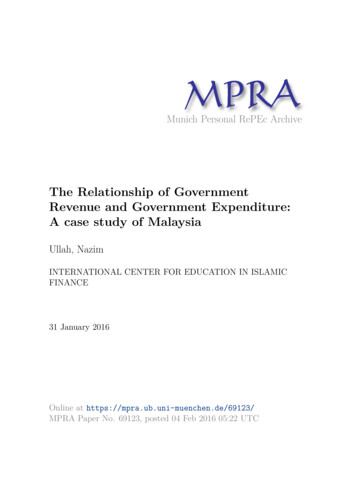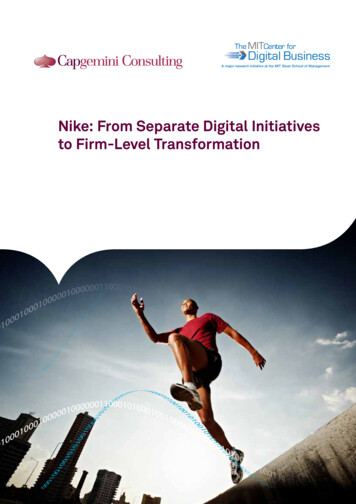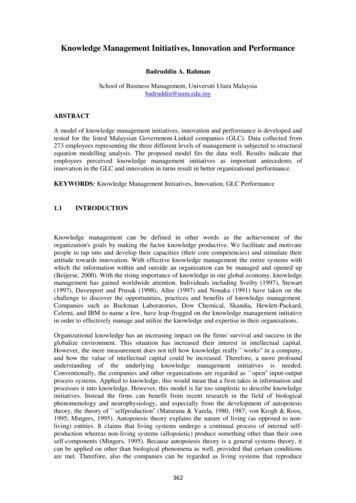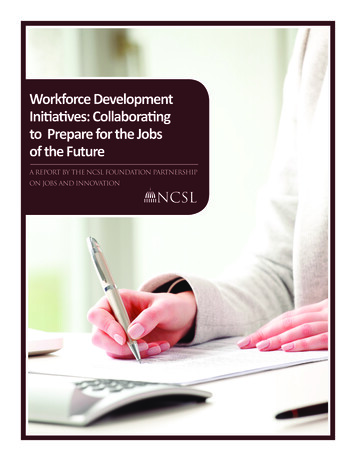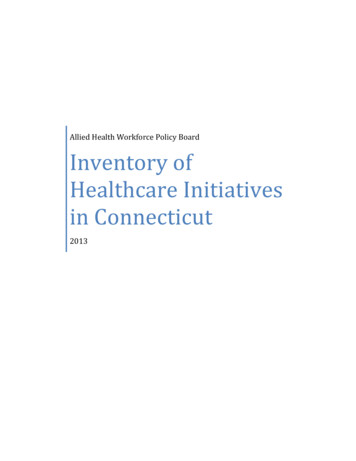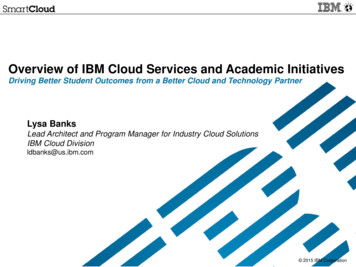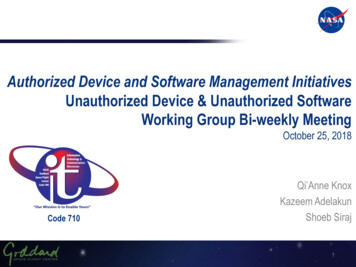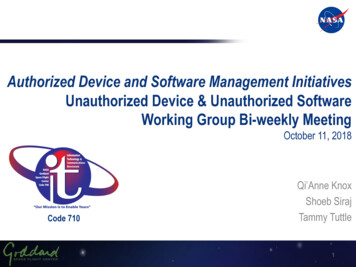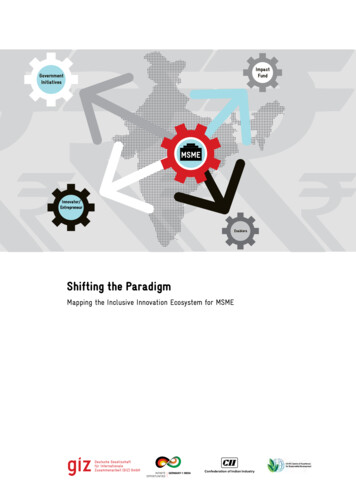
Transcription
preneurEnablersShifting the ParadigmMapping the Inclusive Innovation Ecosystem for MSMEConfederation of Indian Industry
Shifting the ParadigmMapping the Inclusive InnovationEcosystem for MSMEConfederation of Indian Industry
Innovation Ecosystem for MSMEContents02List of AbbreviationsPreludeExecutive Summary040608Chapter 1: MSME Introduction1.1 Introduction – Innovation Paradigm in India1.2 MSME Sector in IndiaA. Constraints in the MSME SectorB. Policy Initiatives by the GovernmentC. MSMEs as a Point of Intervention for Fostering InnovationD. Social Enterprises as MSMEs1.3 The Necessity of an Ecosystem Approach to MSME Innovation1.4 Rationale for the Innovation Ecosystem StudyA. Study FrameworkB. Decoding Innovation1717192021222323242526Chapter 2: Government Initiatives2.1 Introduction2.2 Genesis of Government Schemes for Innovation2.3 Schemes for Innovation Support2.4 Operational StrategiesA. Intervention PointB. Coverage on the Innovation CycleC. Service Delivery2.5 Schemes: Performance2.6 Key Contribution at the Ecosystem Level2.7 Best Practices and Gaps2.8 Challenges2.9 Conclusion31313134363637414346474953Chapter 3: Impact Fund3.1 Introduction3.2 Linking Entrepreneurship and Private Capital- Need for Ecosystem Approach3.3 The Beginning of a New Asset Class3.4 Genesis of Impact Investing in India3.5 Impact Investment Landscape in India3.6 Ecosystem Challenges for Impact Funds3.7 Conclusion5757575959617176
Executive SummaryContentsChapter 4: Innovator4.1 Introduction4.2 Challenges for Innovators in IndiaA. Challenges at Ideation StageB. Challenges at Prototype StageC. Challenges in Pilot TestingD. Challenges in Scale up79797979818384Chapter 5: Recommendations5.1 Introduction: Towards Scalable Innovations for Social Impact5.2 Creating a New Innovation EcosystemLevel 1 Create a New Innovation ParadigmA. Technology for MassesB. The Innovation Model– the Ecosystem ApproachC. The Different Players in the Innovation Eco-systemLevel 2 Strengthen Innovation Schemes and Impact FundsA. Government SchemesB. Impact FundsLevel 3 Building the Innovation Ecosystem5.3 Conclusion87878888888992949499103108Chapter 6: Annexure6.1 Basic Information about Government Schemes6.2 Key Aspects of Government Schemes11011011603
Innovation Ecosystem for MSMEList of POIPRIRRISBITITESITI04Business Advisory ServicesBusiness Development ServicesBusiness IncubatorsBusiness Membership OrganizationsBottom of the PyramidCentral Board of Direct TaxesCluster Development ProgrammeChief Executive OfficerCentre for Educational and Social DevelopmentCommon Facility CentreConfederation of Indian IndustryCentre for Innovation, Incubation & EntrepreneurshipCouncil of Scientific & Industrial ResearchCorporate Social ResponsibilityDepartment of BiotechnologyDevelopment Commissioner (Ministry of Micro, Small & Medium Enterprises)Department of Industrial Policy & ProgrammesDepartment for Scientific and Industrial ResearchDepartment of Science & TechnologyEarly Stage Technology DevelopmentEconomic TimesForeign Direct InvestmentFederation of Indian Chambers of Commerce and IndustryForeign Institutional InvestorFive Year PlanGrassroots Business FundGross Domestic ProductGrassroots Innovation Augmentation NetworkGlobal Impact Investing Rating SystemGeographic Information SystemDeutsche Gesellschaft für Internationale ZusammenarbeitGovernment of IndiaHigh Net Worth IndividualInformation and Communications TechnologyImpact Economy Innovation FundImpact FundIndian Institutes of ManagementIndian Institutes of TechnologyIndian National RupeeIndia Opportunities FundInitial Public OfferingIntellectual Property RightsInternal Rate of ReturnIndian School of BusinessInformation TechnologyInformation Technology Enabled ServicesIndustrial Training Institute
ExecutiveListof n Venture Capital AssociationKhadi and Village Industries CommissionLimited Liabilities CompaniesLimited PartnersMicro EntreprisesMicro-Micro EnterprisesMinistry of FinanceMultinational CorporationMicro, Small and Medium EnterprisesMicro Venture Innovation FundNational Bank for Agriculture and Rural DevelopmentNon-Banking Financial CompanyNon-Governmental OrganizationNational Institute of DesignNational Innovation FoundationNational Institute of Fashion TechnologyNational Innovation CouncilNational Institutes of TechnologyNational Manufacturing Competitiveness ProgrammeNew Millennium Indian Technology Leadership InitiativeNon-Performing AssetNational Small Industries CorporationPrivate EquityProject Monitoring and Advisory CommitteePublic Private PartnershipPromoting Innovations Individual Startups and Micro Small and Medium EnterprisesResearch and DevelopmentRural Innovation FundRural Technology And Business Incubator (RTBI)Science & TechnologySmall Business Innovation Research InitiativeSecurities and Exchange Board of IndiaSustainable Investment in IndiaSmall Industries Development Bank of IndiaSocially Responsible InvestmentsSIDBI Venture Capital LimitedTechnology Development BoardTechnology Development and Information Company of IndiaTechnopreneur Promotion ProgrammeTechnology Information, Forecasting and Assessment CouncilTUC Monitoring CommitteeTePP Screening CommitteeTePP Outreach CenterUnited Nations Development ProgrammeUnited Nations Industrial Development OrganizationUnited States Agency for International DevelopmentUnited States DollarVenture Capital05
Innovation Ecosystem for MSMEPreludeIndia has a rich legacy as the land of innovation and many key innovations of mankind are of Indian origin.The concept of Zero by Aryabhatta and medical surgery by Sushruta are well known. Unfortunately, we seemto have lost focus and are falling behind in the international innovation landscape. However, as an emergingknowledge economy, we have been experiencing the innovation struggle over the last decade. Acknowledgingthe need for innovation in the country, the Prime Minister of India announced the period 2010 – 2020 as “TheDecade of Innovation” and has established the National Innovation Council ( ). A new paradigm of innovationis growing in India that is focusing on simplicity and frugality in the process of innovation itself, in contrastto the dominant paradigm wherein innovation is expensive and requires large resources comprising of highlyqualified personnel, finance and facilities. Innovation is being increasingly regarded as an ‘enabler of inclusivity’by bridging the gap between the resourceful and needy and improving lives of the people at the margin.MSMEs in India are responsible for providing employment to more than 73 million people and account for 8.7percent of country’s GDP. Inspite of producing about 6000 different types of products ranging from traditionalto high-tech, most of them operate at sub optimal levels and are not able to compete globally. As an emerginginvestment destination of foreign capital, technology and products, India needs an innovation strategy thatwould infuse competitive edge in the domestic industries to compete in the global marketplace. Also, with therising inequality in Indian society due to skewed availability of opportunities, the innovation policy shouldcomplement the inclusive growth strategy of the Government.GIZ India, in partnership with the government financial institutions such as SIDBI, has been involved invarious programs to develop MSMEs. The need for creating a robust support structure to expedite innovationsamongst MSMEs has been a major focus for most government policies for quite some time now. Yet, a lot isto be achieved on the ground. This study endeavors to understand the current status of how innovations arenurtured and commercialised by various support structures – on one hand by various government schemes as aplatform to unravel innovations; and on the other, by the new age impact funds through introduction of globalpractices to nurture innovations.To understand the innovation ecosystem, this study has focused on ten government schemes and supportedorganisations that promote innovations and ten Impact Funds that have made their presence felt in lowincome consumer segments. Interaction with senior functionaries who are responsible for managing them wereconducted along with inputs from innovators, start-ups and thought leaders to get a 360 degree perspective ofthe innovation ecosystem. In addition, relevant reports and literature available were studied. Around 50 primaryinterviews were conducted.0612345There are almost 52 government schemes which are in some or the other aspect related to innovations. Afteran objective analysis of the population, 10 schemes were selected for an in-depth analysis. Information weregathered by interacting with senior professionals of the organizations or by referring to available publishedliteratures. The schemes reviewed included:Technoprenuer Promotion Program (TePP)Lockheed Martin India Innovation Growth ProgramSmall Business Innovation Research Initiative (SBIRI)MSME Design Clinic (In partnership with NID)SRIJAN (A partnership between TIFAC & SIDBI)
New Millennium Indian Technology Leadership Initiative (NMITLI)MSME Incubator ProgramMicro Venture Innovation Fund (MVIF)*Rural Innovation Fund (RIF)Centre for Innovation, Incubation and Entrepreneurship (CIIE)*12345678910Similarly, 10 Impact Funds studied included:AavishkarElevar EquityEnnoventGrassroots Business FundIndia Angel NetworkAcumenVillgroArthaUpaya Venture FundAnavo Global Prelude678910Though operating with a likeminded objective of fostering innovations, both the support structures inherentlydiffer in their set of offerings and therefore, were assessed on their individual parameters. However, the scope oftheir operations in all the four stages of innovation namelyIdeationPrototypePilotScale upwere reviewed. The government schemes were further assessed on aspects of inclusivity, accessibility, approvaltime, coverage of the innovation cycle and performance measurement. The Impact Funds were reviewed for theirinvestment focus, stage of the enterprise lifecycle during which the funding is made; investment range; varioustypes of support provided and the number of enterprises funded. Perspective of innovators were understood fordesigning a robust recommendatory roadmap.Footnotes*These initiatives are not only schemes, but unique organisations setup for promoting innovations. For smooth reading it isreferred as Government Schemes.07
Innovation Ecosystem for MSMEExecutive SummaryInnovations Schemes and Impact Funds1 The government schemes for innovation promotion have primarily been focused around the creation of newtechnologies. Various schemes have laid out an operational plan to run the scheme and in the process haveevolved some good practices and propositions. However, as a common factor, most of the schemes are targetedat high-end solutions mainly pursued and promoted by entrepreneurs who are either small or medium andnot the ones operating at the grassroots level targeting users at base of the pyramid. Out of the 10 selectedinitiatives, Rural Innovation Fund(RIF) and Micro Venture Innovation Fund(MVIF) are targeted at creatinginclusive solutions. Also, most government schemes operate at an individual or single enterprise level as apoint of intervention. The ‘Design Clinic Program’ run by the Ministry of MSME is the only cluster basedintervention initiative which aids to scale innovations in MSME clusters. There are some sector based funds. TheDepartment of Biotechnology has programs which are exclusively targeted at solutions related to bio-technologyby individual entrepreneurs/innovators.2 Despite the policy impetus, as an economy we have a long way to go to create a vibrant ecosystem. The MSMEsegment specifically is in a state of concern with outdated technologies and suboptimal levels of production.Some schemes such as the NMCP have tried to take a holistic approach to address the issues of the sector.However, the implementation on ground has been piecemeal and is yet to achieve the desired impact and scale.There is need for coordinated approach and introduction of scale to enable leveraging the impact of innovation.3 In recent years policymakers have been on a major innovation drive which has led to creation of many schemesof similar nature which in turn has led to more confusion due to turf wars, limited bandwidth for operationsand restricted coverage of the innovation cycle. As an idea sourcing platform for new technologies, governmentsupported initiatives have emerged as the recognised and accepted certification agencies by various financialinstitutions. However, the innovative ideas have failed to blossom into viable business models and create a vibrantentrepreneurial society. In all, the study found around 2000 firms to have been supported using public fundingsince 2000. Mostly managed by scientists and technologists, the management of these schemes were found tobe less equipped on matters of financial due-diligence and impact measurement. This lacuna has been addressedin one of the schemes studied, SRIJAN, with partnership emerging between specialised agency like SIDBI (forfinancial assessment) and TIFAC (for technology assessment), thereby leveraging complementary skillsets.However, as per the study, the innovation process is stilted. There is no endeavour to make the process seemlessfor the innopreneur to transits from one stage to the other. The same proposal is vetted multiple times fromscratch at different stages of the innovation lifecycle. The government schemes are focused on the first two stagesof the cycle i.e. ideation and prototype creation while the impact funds enter only once the idea has been testedpost prototype creation. Even at these stages there are no comprehensive services to meet the requirements ofthe respective stage. Further, there is no eco-system or guidance/ mentoring or understanding of what happensto the innopreneur after the specific stage is over and mechanism to ensure that the innovative solution isimplemented on the ground.4 Across schemes, interventions were found to be restricted primarily to financing entrepreneurs who had08readymade technological innovations. The study found an immense need to supplement the financial supportoffered by the government schemes with other non-financial services like mentorship by technology experts
Executive Summaryand business coaches, various types of business development services like market research, branding strategies,vendor sourcing etc. Such an ecosystem based approach with the purpose of inclusion would need a completeoverhaul of the government support structure from being a technology based fund provider to a solution basedco-creator.Another key aspect on which the government schemes were found to be seriously lacking was not conductingimpact assessment studies. Monitoring and impact assessment are an integral part of any programme to gaugeits effectiveness. In addition to measuring performance of the incubated enterprises, it also helps in gauging theimpact created by the support scheme at the national level. Conducting impact assessment studies in a timelymanner would help the policy makers in invigorating a result based culture and a robust review system formeasuring the performance of various government schemes. This would also facilitate higher allocation of fundsto schemes that are performing well and delivering on the scheme objectives.As an important stakeholder of the innovation ecosystem, the academia has a crucial role to play. There is animpending need of re-inventing the curriculum of engineering and ITI courses. By creating a national networkof laboratories and testing facilities, and linking the live projects of their students to the various governmentschemes, the academic institutions can become major sources of innovations. Moreover, we recommend linkingthe industrial clusters with such institutes for a contextual understanding of the actual problems faced by theindustry leading to co-created sustainable solutions.In terms of operational processes and accessibility of the government schemes across geographic locations andsections of society, we recommend a two-tier approach –the approval and funding decisions be retained by theapex level (in New Delhi); awareness creation and hand holding during the submission process, monitoring andimpact assessment, mentoring and managing should be left to the regional centres which can act as incubationhubs. This decentralised approach would entail benefits like faster processing of the application, bettermonitoring of the incubated firms and cost savings in terms of doing away with redundant processes.5 Thus far the innovation focus has been on technology improvements for the MSME, in line with the growthobjectives and to give the much needed boost to the manufacturing sector. Going forward, in line with theinclusivity and scalability objectives of the NIC, a two pronged innovation approach needs to be followed.Government schemes now need to expand their scope and base in order to create solutions that would createmaximum impact on the BoP. This requires a total change in mindset and methodology. These programs needto find answers on ways to move away from only technological solutions to more holistic business modelapproach and to creation of impact through an inclusive approach. Bringing in project management skills to runlarge scale programs is the need of the hour. The ability to collaborate with various stakeholders to integrate allthe services needed by innovators is an important area for the schemes to work on. Critical non-financial serviceslike market research, business modelling, mentoring services etc. need to be integrated into the schemes. Aboveall, the schemes need to move away from schematic approach to a more holistic one for creating an enablingenvironment and this remains a big challenge.6 Impact funds, on the other hand, are relatively new players and have barely touched the tip of the iceberg. Theyhave been gradually evolving as holistic service providers to innovators and aim at creating the much neededsocial impact. As an emerging asset class, they gathered momentum post 2008 and presently around 33 of themoperate in India. The Planning Commission estimates an investment demand of 55 billion (INR 3 lakh crore)by potential start-ups over this decade. Impact investing involves “investors seeking to generate both financialreturn and social and/or environmental value – while at a minimum returning capital, and, in many cases,offering market rate returns or better1.”7 Impact investing has seen a lot of traction in the last couple of years due to a growing recognition that existingresources are insufficient to address severe poverty, inequality, environmental destruction and other complex,09
Innovation Ecosystem for MSMEglobal issues, especially among western nations that are already reducing their aid budgets and domestic socialspending. An emerging set of activities demonstrate that it is possible to finance scalable business models thatcreate social and environmental value. Also, there is a transfer of wealth from high net worth individuals inindustrialized nations who seek to embed their values while allocating their capital. According to the 2009Monitor Institute report entitled Investing for Social and Environmental Impact “Impact investing remains inthe market-building phase, but could evolve to the next phase in which stakeholders fully capture the value ofthe marketplace.” In India, especially since 2008, there has been a sudden spurt in the growth o
Grassroots Business Fund India Angel Network Acumen Villgro Artha Upaya Venture Fund Anavo Global ough operating with a likeminded objective of fostering innovations, both the support structures inherently di er in their set of o erings and therefore, were asses
